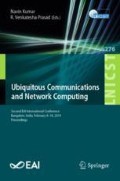Abstract
Computer system security has related to security of software or the information processed. The underlying hardware used for information processing has considered to as trusted. The emerging attacks from Hardware Trojans (HTs) violate this root of trust. The attacks are in the form of malicious modification of electronic hardware at different stages; possess major security concern in the electronic industries. An adversary can mount HT in a net of the circuit, which has low transition probability. In this paper, the improvement of the transition probability by using test points and weighted random patterns is proposed. The improvement in the transition probability can accelerate the detection of HTs. This paper implements weighted random number generator techniques to improve the transition probability. This technique is evaluated on ISCAS 85’ benchmark circuit using PYTHON and SYNOPSYS TETRAMAX tool.
Access this chapter
Tax calculation will be finalised at checkout
Purchases are for personal use only
References
Bhunia, S., et al. Hardware Trojan attacks: threat analysis and countermeasures. Proc. IEEE 102(8), 1229–1247 (2014). Author, F., Author, S.: Title of a proceedings paper. In: Editor, F., Editor, S. (eds.) CONFERENCE 2016, LNCS, vol. 9999, pp. 1–13. Springer, Heidelberg (2016)
Rad, R., Plusquellic, J., Tehranipoor, M.: Sensitivity analysis to hardware Trojans using power supply transient signals. In: Proceedings of IEEE International Workshop on Hardware-Oriented Security Trust (HOST), Anaheim, CA, USA, pp. 3–7 (2008)
Cha, B., Gupta, S.K.: Trojan detection via delay measurements: a new approach to select paths and vectors to maximize effectiveness and minimize cost. In: Proceedings of IEEE Design, Automation and Test in Europe Conference Exhibit. (DATE), Grenoble, France, pp. 1265–1270 (2013)
Zhou, E., Li, S., Zhao, Z., Ni, L.: Nonlinear analysis for hardware Trojan detection. In: 2015 IEEE International Conference on Signal Processing, Communications and Computing (ICSPCC), Ningbo, pp. 1–4 (2015). https://doi.org/10.1109/icspcc.2015.7338921
Zhang, Z., Li, L., Tang, T., Wei, Z.: Side channel analysis of hardware Trojan based on smooth filtering algorithm. In: 2015 8th International Symposium on Computational Intelligence and Design (ISCID), Hangzhou, pp. 192–195 (2015). https://doi.org/10.1109/iscid.2015.253
Chakraborty, R.S., Wolff, F., Paul, S., Papachristou, C., Bhunia, S.: MERO: a statistical approach for hardware Trojan detection. In: Clavier, C., Gaj, K. (eds.) CHES 2009. LNCS, vol. 5747, pp. 396–410. Springer, Heidelberg (2009). https://doi.org/10.1007/978-3-642-04138-9_28
Jha, S., Jha, S.K.: Randomization based probabilistic approach to detect Trojan circuits. In: 2008 11th IEEE High Assurance Systems Engineering Symposium, Nanjing, pp. 117–124 (2008). https://doi.org/10.1109/hase.2008.37
Yoshimura, M., Bouyashiki, T., Hosokawa, T.: A hardware Trojan circuit detection method using activation sequence generations. In: 2017 IEEE 22nd Pacific Rim International Symposium on Dependable Computing (PRDC), Christchurch (2017). https://doi.org/10.1109/prdc.2017.40
He, C., Hou, B., Wang, L., En, Y., Xie, S.: A novel hardware Trojan detection method based on side-channel analysis and PCA algorithm. In: 2014 10th International Conference on Reliability, Maintainability and Safety (ICRMS), Guangzhou (2014). https://doi.org/10.1109/icrms.2014.710736221-222
Huang, Y., Bhunia, S., Mishra, P.: Scalable test generation for Trojan detection using side channel analysis. IEEE Trans. Inf. Forensics Secur. 13(11), 2746–2760 (2018). https://doi.org/10.1109/tifs.2018.2833059. 1043–1046
Devi, N.M., Jacob, I.S., Ranjani, S.R., Jayakumar, M.: Detection of malicious circuitry using transition probability based node reduction technique. http://dx.doi.org/10.12928/telkomnika.v16i2.6812
Zhou, B., Zhang, W., Thambipillai, S., Jin, J.T.K., Chaturvedi, V., Luo, T.: Cost-efficient acceleration of hardware Trojan detection through fan-out cone analysis and weighted random pattern technique. IEEE Trans. Comput.-Aided Des. Integr. Circuits Syst. 35(5), 792–805 (2016). https://doi.org/10.1109/tcad.2015.2460551
Karunakaran, D.K., Mohankumar, N.: Malicious combinational Hardware Trojan detection by gate level characterization in 90 nm technology. In: Fifth International Conference on Computing, Communications and Networking Technologies (ICCCNT), Hefei, pp. 1–7 (2014). https://doi.org/10.1109/icccnt.2014.6963036
Lee, H., Kang, S.: A new weight set generation algorithm for weighted random pattern generation. In: Proceedings 1999 IEEE International Conference on Computer Design: VLSI in Computers and Processors (Cat. No. 99CB37040), Austin, TX, USA, pp. 160–165 (1999). https://doi.org/10.1109/iccd.1999.808421
Kirn, H.-S., Lee, J.K., Kang, S.: A new multiple weight set calculation algorithm. In: Proceedings International Test Conference 2001 (Cat. No. 01CH37260), Baltimore, MD, USA, pp. 878–884 (2001). https://doi.org/10.1109/test.2001.966710
Yeap, G.: Practical Low Power Digital VLSI Design. Springer, Heidelberg (1998). https://doi.org/10.1007/978-1-4615-6065-4
Author information
Authors and Affiliations
Corresponding author
Editor information
Editors and Affiliations
Rights and permissions
Copyright information
© 2019 ICST Institute for Computer Sciences, Social Informatics and Telecommunications Engineering
About this paper
Cite this paper
Mohapatra, K.C., Priyatharishini, M., Nirmala Devi, M. (2019). Improving Transition Probability for Detecting Hardware Trojan Using Weighted Random Patterns. In: Kumar, N., Venkatesha Prasad, R. (eds) Ubiquitous Communications and Network Computing. UBICNET 2019. Lecture Notes of the Institute for Computer Sciences, Social Informatics and Telecommunications Engineering, vol 276. Springer, Cham. https://doi.org/10.1007/978-3-030-20615-4_16
Download citation
DOI: https://doi.org/10.1007/978-3-030-20615-4_16
Published:
Publisher Name: Springer, Cham
Print ISBN: 978-3-030-20614-7
Online ISBN: 978-3-030-20615-4
eBook Packages: Computer ScienceComputer Science (R0)

